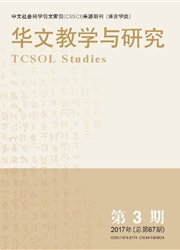

 中文摘要:
中文摘要:
本文以HSK[高级]考试的实测数据为研究材料,使用结构方程模型探究高级汉语学习者听、说、读、写四项技能的结构模式以及四项技能间的融合/分散趋势。对包含一阶因子模型和高阶因子模型在内的9个理论模型的验证结果显示:高级水平汉语学习者技能结构模式可以用"听读+说+写"的形式进行描述,四项技能中听力和阅读呈现融合的趋势,相对而言,说的技能与其它技能的区分性比较高,高级水平汉语学习者听、说、读、写四项技能呈现出部分融合的趋势。研究认为,HSK[高级]考试采用主试卷、口语试卷和写作试卷三部分各自独立施测的方法 ,并将听力和阅读分数进行综合报道,口语、写作分数独立报道,这种做法具有一定的合理性。
 英文摘要:
英文摘要:
This study investigates the factor structure of the four language skills of the advanced Chinese learners and the integrated/differential trend of the four skills,by applying the structural equation modeling to the data of HSK [advanced] test.The finding of the confirmatory factor analyses of the 9 competing factor models indicates that,the three factor first-order model(listening reading + speaking + writing) is best suited to describe the language ability of advanced Chinese learners,and the listening skill and reading skill take on a integrative trend,comparatively,speaking skill is more differentiated from the other three skills.It is found that for advanced learners,the relationship of four language skills,i.e.listening,speaking,reading and writing,presents a partly integrative trend.Thus,we conclude that HSK[advanced] test offers a reasonable test structure and suitable scoring system by separating the main test paper,speaking paper and writing paper,and scoring listening and reading comprehensively,but speaking and writing separately.
 同期刊论文项目
同期刊论文项目
 同项目期刊论文
同项目期刊论文
 期刊信息
期刊信息
